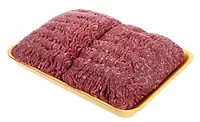Research: Old Technique Greatly Reduces Salmonella in Ground Meats

New research presented this week has revealed that an old technique can reduce the presence of Salmonella in meat by as much as 90 percent. The findings and supporting data were presented by a University of Nevada (Reno) assistant professor at the American Meat Science Association’s conference earlier this week in Texas.
“We were able to reduce Salmonella by as much as 90 percent in ground poultry, ground pork and ground beef. We’re excited to be able to show such good results, food safety is an important part of our work and salmonella is one of the most prevalent bacteria in the nation’s food supply.” says assistant professor Amilton de Mello, representing the university’s College of Agriculture, Biotechnology and Natural Resources.
The technique that’s been found to reduce Salmonella bacteria is actually an old technology. Bacteriophages--natural bacteria predators--was used to treat meat products that were infected with four types of Salmonella. Bacteriophages are viruses that can only harm specific bacterial cells and are harmless to humans, animals and plants. They are commonly found in natural environments.
In the experiments, the Salmonella bacteria was inoculated on refrigerated meat and poultry trim, then the treatment was applied to the meat before grinding. The bacteriophages invaded the cells of the bacteria and destroyed them.
“On the final ground meat products, there was a 10-fold decrease of Salmonella,” says de Mello. “The results are very encouraging and we’re hoping this can be adopted by the meat industry to increase food safety.”
Every year, Salmonella is estimated to cause one million foodborne illnesses in the U.S., with 19,000 hospitalizations and 380 deaths, according to the U.S. Centers for Disease Control and Prevention.
Sign up for Food Safety Magazine’s bi-weekly emails!
Looking for quick answers on food safety topics?
Try Ask FSM, our new smart AI search tool.
Ask FSM →








